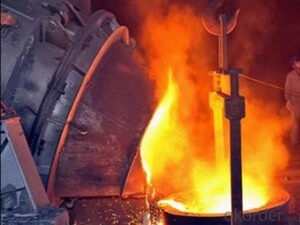The temperature in the AOD furnace is about 1500-1800℃ during smelting. During actual smelting, due to the discontinuity of furnace operation, the temperature difference on the surface of the lining bricks is large, causing intermittent breakage of the lining surface, and the surface of the refractory bricks exposed to humid air reacts to cause surface corrosion, causing the lining to fall off.

There are four main stages of lining erosion during AOD furnace smelting
1. Reduction stage
The reduction stage is the stage where molten steel is added to the furnace body and additives are added to the molten steel. In this stage, the alkalinity of the molten steel is the lowest, and the calcium oxide from the slag and lining bricks reacts with silicon dioxide. Calcium oxide is one of the components of lining bricks. The chemical reaction of calcium oxide destroys the structure of the lining bricks and causes erosion.
2. Early stage of smelting
In the early stage of smelting, the reason why the AOD furnace lining is corroded is that there is less slag in the molten iron, the alkalinity of the molten iron is low, and the calcium oxide in the lining is forced to participate in the reaction to cause corrosion. This stage is the stage with the lowest alkalinity of the molten iron in the entire smelting process except the reduction stage.
3. Oxidation period
When the smelting reaction stage reaches the oxidation period, and the TFe (ferroalloy) content corresponding to a certain alkalinity in the molten steel reaches or exceeds 20%, the MgO and CaO in the refractory bricks react with the FeO, Cr2O3, MnO, and SiO2 in the furnace to form CaO-Cr2O3-SiO2, MgO-Cr2O3·MnO·FeO, and CaO-Cr2O3·MnO-FeO, which accelerates the erosion rate.
4. Highest temperature stage
The refractory temperature of the magnesia-calcium bricks used in the furnace lining is about 1700℃, and in the reactor, the highest temperature stage reaches about 1800℃, which greatly exceeds the upper temperature limit of the refractory bricks. After exceeding the upper temperature limit, the corrosion resistance of refractory bricks decreases sharply. According to relevant experiments, after exceeding the limit, the loss of refractory materials increases by 1 times for every 50°C increase in temperature.
